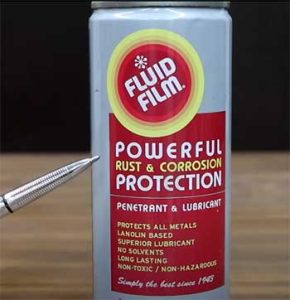When you’re in the thick of a project, grappling with rusty bolts and stubborn joints, the last thing you need is your penetrating oil to let you down. It’s the unspoken duel of two market dominators – Fluid Film and PB Blaster.
As the heat of the debate continues to fuel online forums and garage discussions, let’s put these two powerhouses under the microscope.
A Brief Comparison Table
| Factors | Fluid Film | PB Blaster |
| Primary Use | Rust prevention and Lubrication | Penetrating rusted/seized parts |
| Base Ingredient | Lanolin (Wool grease) | Petroleum-based |
| Environmental Impact | Eco-friendly and Biodegradable | Not notably eco-friendly |
| Duration of Effect | Long-lasting due to non-drying formula | Requires reapplication over time |
| Water Resistance | Excellent, even in saltwater conditions | Good, but not specifically designed for maritime conditions |
| Lubrication | Excellent | Moderate |
| Penetration | Moderate | Excellent |
| Use in Extreme Conditions | Performs well under various conditions | Excels even under extreme conditions |
| Industrial Usage | Used widely in automotive, marine, agricultural, and general industrial applications | Primarily used for automotive and industrial applications |
The Rundown on Fluid Film

At the heart of Fluid Film is lanolin, a substance naturally derived from wool-bearing animals.
This eco-friendly and biodegradable ingredient provides Fluid Film with its unique water-repellant and corrosion-resistance properties.
It’s a tough adversary for rust, and its non-drying formula creates a long-lasting layer of protection.
A Closer Look at PB Blaster
On the flip side, we have PB Blaster, a veteran penetrating oil and rust inhibitor known for its tenacity.
It stands out for its high performance in breaking free rusted and seized parts.
It’s your go-to when you’re stuck with a rusted bolt, thanks to its capillary action that penetrates deep into tight crevices.
Comparing The Titans: Fluid Film and PB Blaster
There are few things as satisfying as the crack of a rusted bolt finally giving way. It’s a moment of victory that both Fluid Film and PB Blaster promise to deliver. But how do they stack up against each other?
- Efficiency and Versatility
Fluid Film excels at preventing corrosion, making it ideal for long-term protection. It also doubles as an excellent lubricant, reducing friction and prolonging the life of your tools.
PB Blaster, meanwhile, is a master at penetrating rusted parts. Its capillary action lets it work its magic deep inside the stubborn rusted joints. However, as a lubricant, it falls short of Fluid Film’s performance.
- Application and Longevity
Fluid Film’s non-drying formula allows for easy application and reapplication, while PB Blaster tends to evaporate over time and may require more frequent applications. If long-lasting protection is what you seek, Fluid Film takes the cake.
- Environmental Impact
Environmentally conscious users might lean towards Fluid Film, given its eco-friendly and biodegradable nature. PB Blaster, while effective, doesn’t come with the same environmental credentials.
The Power Features of Fluid Film
- Eco-friendly and Biodegradable
Derived from lanolin, Fluid Film is an eco-friendly solution. It’s biodegradable, non-toxic, and free from heavy metals and solvents, which adds up to an environmentally conscious choice.
- Long-Lasting Protection
Its unique, non-drying formula creates a wet film that provides long-lasting protection against corrosion. Once applied, Fluid Film continues to actively shield and lubricate, even under harsh conditions.
- Water and Saltwater Resistant
Another standout feature of Fluid Film is its excellent resistance to water and saltwater. This makes it a prime choice for marine applications, providing robust protection in high humidity and salt air environments.
- Excellent Lubrication
Beyond its anti-corrosion properties, Fluid Film is an excellent lubricant. It greatly reduces friction, promoting smooth operation and prolonging the life of tools and equipment.
The Power Features of PB Blaster
- High-Performance Penetration

PB Blaster is designed to break through rust and free up seized parts.
Its penetrating formula with capillary action seeps into the smallest crevices, reaching deep to break the rust bonds.
- Fast Acting
PB Blaster’s formula is known for its quick action.
It gets to work immediately, penetrating rusted parts and delivering results in a matter of minutes.
- Works under Extreme Conditions
PB Blaster performs impressively even under extreme conditions. It withstands high temperatures, making it a reliable choice for various industrial applications.
- Non-Evaporating Formula
Although not as long-lasting as Fluid Film, PB Blaster’s formula is designed not to evaporate quickly. This ensures that it stays active longer, keeping those seized parts lubricated for a decent amount of time.
Also Read: Differences Between POR-15 And Fluid Film.
Frequently Asked Questions (FAQ)
Fluid Film excels due to its versatility. It’s not only an effective rust inhibitor but also a remarkable lubricant. Its non-drying, lanolin-based formula provides long-lasting protection and is eco-friendly, making it a superior choice for many users.
Absolutely! Fluid Film has been a trusted name in the industry for decades. Its ability to prevent corrosion and lubricate moving parts is well-documented and widely acknowledged. Whether you’re looking to safeguard your garden tools, marine equipment, or vehicle undercarriage, Fluid Film is up to the task.
While Fluid Film offers some level of penetrating ability, it’s primarily designed for corrosion prevention and lubrication. If you’re dealing with stubborn, rusted parts, a specialized penetrating oil like PB Blaster might prove more efficient.
Indeed, they do! Fluid Film has a rich history of use in maritime settings due to its excellent corrosion resistance. Its ability to repel saltwater makes it a favorite choice in naval and marine applications, both for the U.S. Navy and commercial fishing industries.
Wrapping Up
In the ultimate showdown between Fluid Film and PB Blaster, your choice largely depends on your specific needs. If you seek a versatile, long-lasting, and eco-friendly rust inhibitor and lubricant, Fluid Film is your best bet.
However, if you’re battling with deeply rusted and seized parts, PB Blaster’s penetrating prowess cannot be overlooked.
So, the next time you find yourself in a cloud of rust dust, remember, there’s a mighty solution within your reach – be it Fluid Film or PB Blaster, each has its unique strength that brings you a step closer to your victory against rust.



